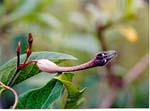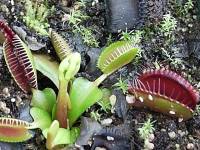Jayant Deshpande
( Photograph of Peacock flytrap by Jayant Deshpande)
 Found in the Western Ghats this plant is an annual twiner. Every Monsoon the plant springs to life from the tuber underground, and flowers. The tip of flower looks like
a snake head. The long tube like structure contains stiff bristles. These bristles allow one-way entry for the small insects that enter the flowers for nectar, which is in the bulb at the far end. Once the insect reaches the bulb and accidentally pollinates
the flower the bristles fall down allowing the insect to go out. Hence the name Peacock Fly trap.
Found in the Western Ghats this plant is an annual twiner. Every Monsoon the plant springs to life from the tuber underground, and flowers. The tip of flower looks like
a snake head. The long tube like structure contains stiff bristles. These bristles allow one-way entry for the small insects that enter the flowers for nectar, which is in the bulb at the far end. Once the insect reaches the bulb and accidentally pollinates
the flower the bristles fall down allowing the insect to go out. Hence the name Peacock Fly trap.
Caterpillars of the Striped Tiger, and the Glassy Tiger butterfly relish the poisonous leaves of this plant. The tubers are cooked and eaten by tribals like potatoes. Extensive
tuber collections coupled with habitat destruction have unfortunately endangered this plant. More research on this plant may throw up interesting insights.
A well known Flytrap of the West is 'Venus flytrap'. ( Photo by Lindsay Boyd )
 Just like other plants, Venus' Flytraps gather nutrients from gases in the air and nutrients in the soil. However, they live in poor soil and are healthier if they get
nutrients from insects. Carnivorous plants live all over the world but Venus' Flytraps live only in select boggy areas in North and South Carolina. Because of people's fascination with these plants, they collected many of them and they became endangered. Venus'
Flytraps today are grown in greenhouses.
Just like other plants, Venus' Flytraps gather nutrients from gases in the air and nutrients in the soil. However, they live in poor soil and are healthier if they get
nutrients from insects. Carnivorous plants live all over the world but Venus' Flytraps live only in select boggy areas in North and South Carolina. Because of people's fascination with these plants, they collected many of them and they became endangered. Venus'
Flytraps today are grown in greenhouses.
The leaves of Venus' Flytrap open wide and on them are short, stiff hairs called trigger or sensitive hairs. When anything touches these hairs enough to bend them, the two
lobes of the leaves snap shut trapping whatever is inside. The trap will shut in less than a second. The trap doesn't close all of the way at first. It is thought that it stays open for a few seconds in order to allow very small insects to escape because they
wouldn't provide enough food. If the object isn't food, e.g., a stone, or a nut, the trap will reopen in about twelve hours and 'spit' it out.
When the trap closes over food, the cilia. finger-like projections, keep larger insects inside. Fold your hands together lacing your fingers to see what the trap looks like.
In a few minutes the trap will shut tightly and form an air-tight seal in order to keep the digestive fluids inside and bacteria out.
If an insect is too large it will stick out of the trap. This allows bacteria and molds on the insect to thrive. Eventually the trap turns black, rots and falls off.
The trap constricts tightly around the insect and secretes digestive juices, much like those in your stomach. It dissolves the soft, inner parts of the insect, but not the
tough, outer part called the exoskeleton. At the end of the digestive process, which takes from five to twelve days, the trap reabsorbs the digestive fluid and then reopens. The leftover parts of the insect, the exoskeleton, blow away in the wind or are washed
away by rain. The time it takes for the trap to reopen depends on the size of the insect, temperature, the age of the trap, and the number of times it has gone through this process.